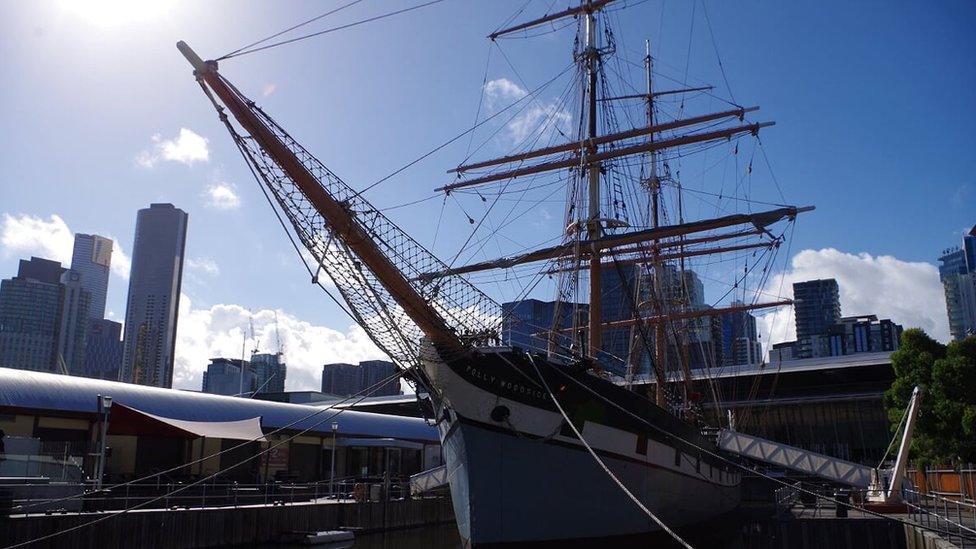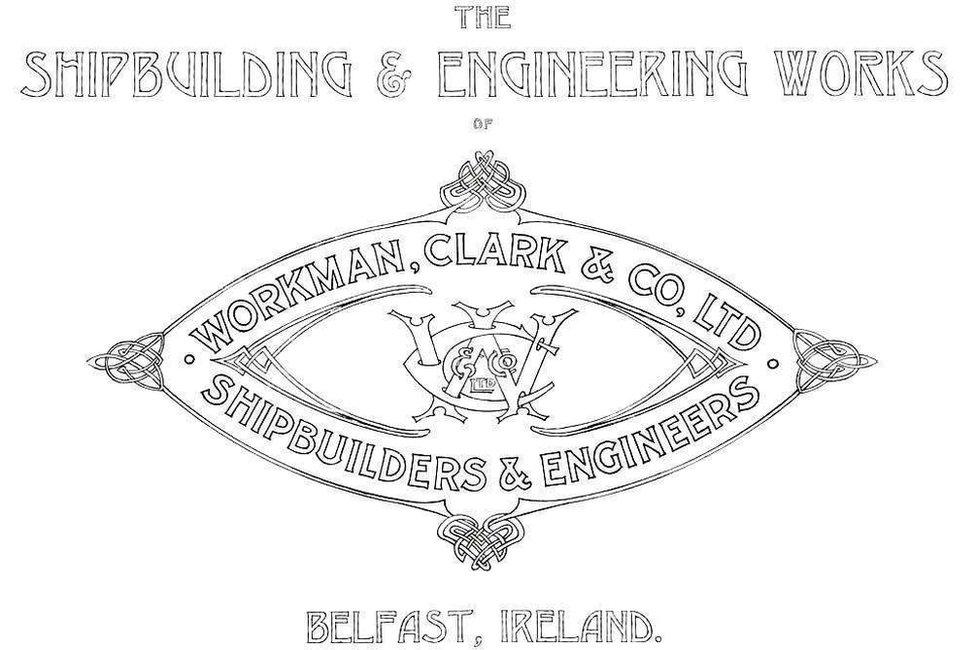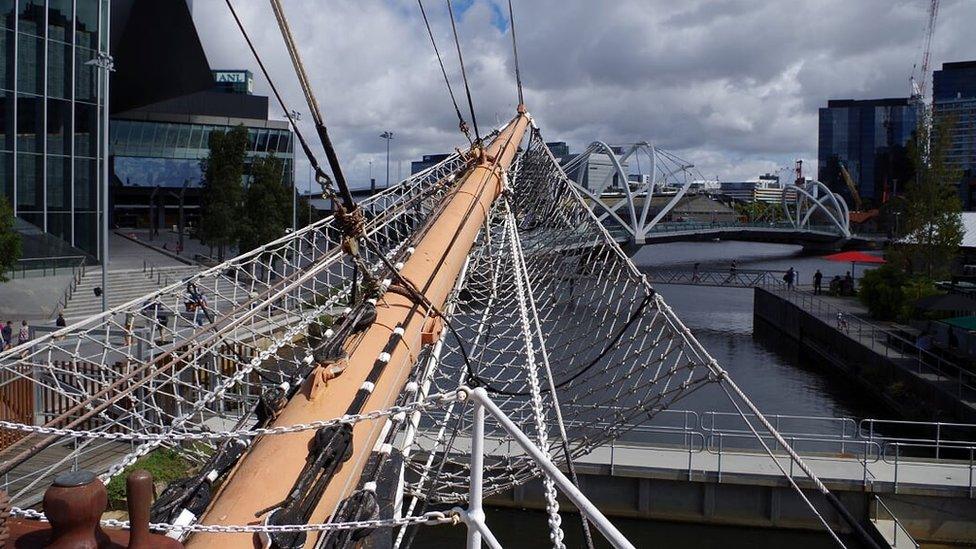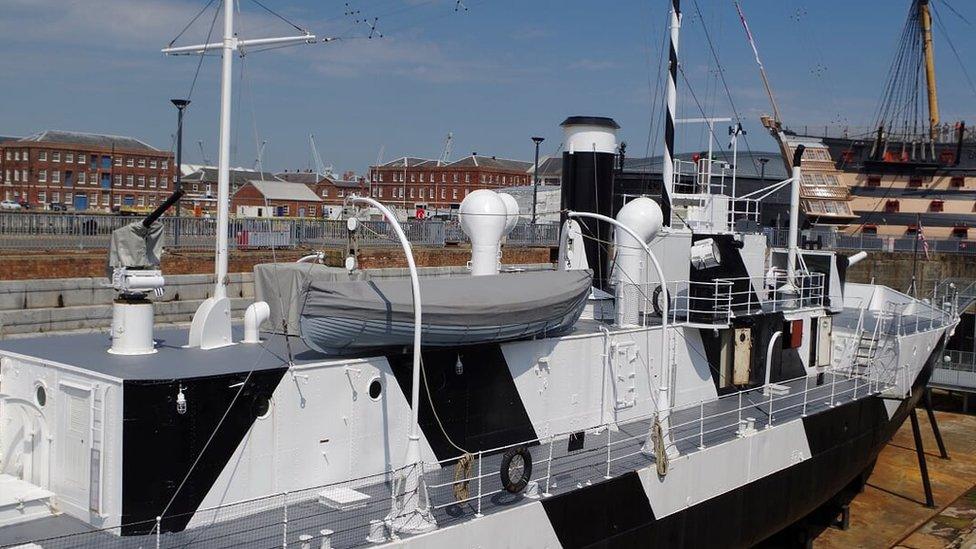Belfast built: A tale of two ships
- Published

The Polly Woodside at her berth on Melbourne's Lower Yarra River
Everyone's heard of the Titanic and the tragic story of the liner's encounter with a North Atlantic iceberg in 1912.
Even though the ship lies two miles under the surface of the ocean, Belfast's tourist industry is partly based on the story of the ship's construction at the Harland and Wolff shipyard.
Less well known are the Polly Woodside and HMS M.33, two ships built at Workman and Clark, the city's forgotten "Wee Yard", now moored on distant shores and welcoming visitors with a love of seafaring.

Frank Workman and George Clark were two young former Harland and Wolff apprentices who launched their own business on the north bank of the River Lagan in 1880.
Maureen McKinney of the Belfast Titanic Society explains that the yard wasn't as "wee" as the name suggests:
"There were four years when it outstripped Harland and Wolff in tonnage between 1900 and 1913.
"At its peak it had 12,000 workers. That was at the end of the First World War when it was doing a lot of work for the Admiralty."

Along the bowsprit of the Polly Woodside
In June 1918, Workman and Clark riveter John Moir drove 11,209 rivets during a nine-hour shift - a world record that stands to this day.
Polly Woodside is a three-masted merchant ship launched at the yard in 1885 - she's now one of the top tourist attractions in Melbourne, Australia.
Shara Canzana of the National Trust of Australia explained that the iron-hulled barque was built for the South American trade:
"She provided a cheaper means of transport for the coal industry of south Wales to the favoured route of South America.
Chilean nitrates
Polly's maiden voyage set sail to Chile via Uruguay, which took just over a year.
She shipped coal over to South America and would then return with cargo such as linseed, barley and more usually, Chilean nitrates."
Polly Woodside survived when her contemporaries were scrapped because she was stripped down to serve as a refuelling transport for coal-burning ships.
In 1968, the ship was sold to the National Trust for one cent. Volunteers turned their hands to sand blasting, welding, making rigging and cleaning out years of coal dust from the hull.
The 135-year-old workhorse now features an award-winning interactive gallery on its history and has become a valuable resource for primary school pupils.

HMS M.33 with Nelson's flagship, Victory, in the background
The other restored Workman and Clark ship serving as a tourist attraction is the stubby little gunship HMS M.33. which sits in pride of place alongside Nelson's flagship, HMS Victory, in Portsmouth Historic Dockyard.
M.33 is a monitor, a floating inshore gun platform, that first saw action at Gallipoli in 1915.

HMS M.33 near Gallipoli in 1915
Matthew Sheldon, director of heritage at the dockyard, explained that monitors were designed and built at speed and intended to carry whatever big guns the Royal Navy had available at the time.
It took just four months from the laying of the keel in Belfast to M.33's deployment in the Dardanelles.
"It was quite expendable, which is not great if you're a member of the crew - there's no armour," Mr Sheldon added.

M.33 in dazzle camouflage intended to break up the outline of the ship when viewed from a distance
Given that M.33 was a sitting duck she survived the war unscathed and gained a reputation as a lucky ship.
That luck ran out when M.33 joined the Allied intervention against the Bolshevik revolution in northern Russia in 1919.
The little ship's shallow draught allowed her to travel 200 miles up the River Dvina where she came under heavy shellfire and was badly damaged.
"That's what she was there for. She was expendable," said Mr Sheldon.
Beyond memory
Only three Royal Navy ships survive from World War One, one of them is HMS Caroline, now permanently moored in Belfast's Titanic Quarter.
Workman and Clark closed in 1935, a victim of the 1930s depression and questionable business decisions that led to some very expensive court cases.
"It's outside of most people's memory now," said Maureen McKinney.
The physical signs of the yard's existence at Spencer Dock may have gone as well but two remarkable ships continue the story of Workman and Clark, a part of Belfast's rich industrial history.